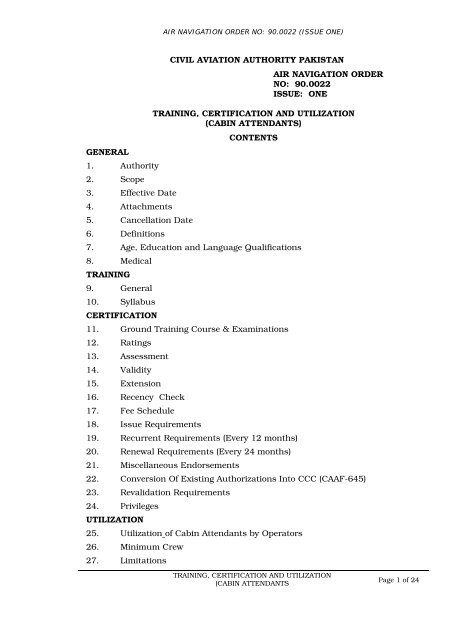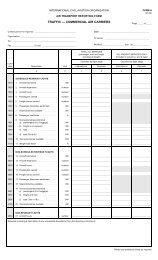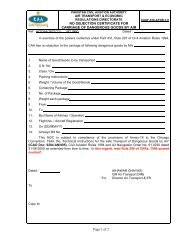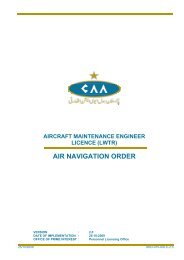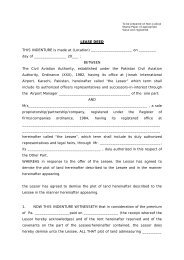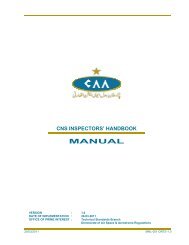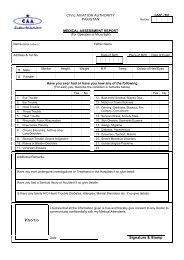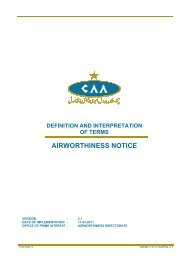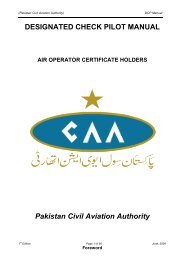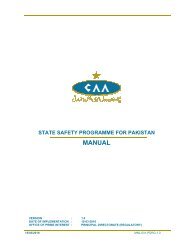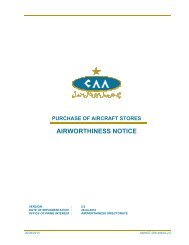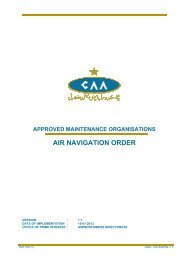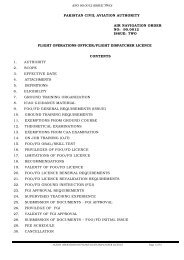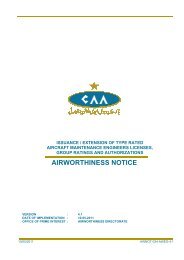CIVIL AVIATION AUTHORITY, PAKISTAN
CIVIL AVIATION AUTHORITY, PAKISTAN
CIVIL AVIATION AUTHORITY, PAKISTAN
- No tags were found...
You also want an ePaper? Increase the reach of your titles
YUMPU automatically turns print PDFs into web optimized ePapers that Google loves.
6.17. Pilot-in-Command: The pilot responsible for the operation and safetyof the aircraft during flight time.6.18. Rating: An authorization entered on or associated with a Licence orCertificate and forming part thereof, stating special conditions,privileges or limitations pertaining to such Licence or Certificate.6.19. Differences Training: Differences training is a training whichcomprises all the appropriate elements or components of differentequipment, equipment location, or safety procedures on currentlyoperated aircraft types or variants.7. AGE, EDUCATION AND LANGUAGE QUALIFICATIONS7.1. The following requirements shall be applicable for age, educationalrequirements and proficiency in language:8. MEDICAL7.1.1. Education: Intermediate or equivalent.7.1.2. Age: 18 years.7.1.3. Language: Should be able to speak, read and write Englishand the national language.8.1. The applicant shall meet the following medical requirements:8.1.1. Class II Medical.8.1.2. Able to reach safety equipment and open and close theoverhead bins in standing position in the specific aircraft.8.1.3. Weight: Should be proportionate to age, height ratio providedthe applicant is:8.1.3.1. Able to move comfortably down the aisle, single file,facing forward.8.1.3.2. Able to pass quickly through the smallest cabinemergency exit window.8.1.3.3. And an appropriate height/weight ratio.TRAINING9. General9.1. The training shall be conducted in an Approved Aviation Centre. TheAviation Training Centre shall ensure that the training is conductedin accordance with the ICAO document 7192 AN/857 Part E-1(Second Edition) and the details provided below. The Centre shallobtain a prior approval from the CAA before commencing the initialtraining course10. SYLLABUSPage 4 of 24
10.1. <strong>AVIATION</strong> INDOCTRINATION10.1.1. Regulatory aspects10.1.1.1. National and International10.1.1.2. Company-specific10.1.2. Aviation Terminology and terms of ref.10.1.2.1. Terminology10.1.2.2. Terms of reference10.1.3. Theory of flight & aircraft Operation (Basic Information)10.1.3.1. Theory of flight10.1.3.2. Major aircraft components10.1.3.3. Critical surfaces (contamination of)10.1.3.4. Pressurization system10.1.3.5. Weight and balance10.1.3.6. Meteorology/ Turbulence10.1.3.7. Communications equipment10.1.3.8. Air Traffic control10.1.4. Physiology of flight10.1.4.1. Oxygen system and use10.1.4.2. Effects of altitude10.1.4.3. Cabin poisoning10.2. DUTIES & RESPONSIBILITIES10.2.1. General responsibilities10.2.2. Pre-flight and post-flight10.2.3. In-flight10.3. EMERGENCY PROCEDURES10.3.1. Gen. Emg. Procedures & basic principles10.3.2. Emergency equipment10.3.3. Fire fighting10.3.4. Smoke removal procedures10.3.5. Emergency lighting systems10.3.6. Decompression-slow/Rapid10.3.7. Emergency landing preparations10.3.8. Evacuation proceduresPage 5 of 24
10.3.9. Unwarranted evacuations-water ditching10.3.10. Life-and slide-rafts (use of)10.3.11. Unlawful interference10.4. CARRIAGE OF DANGEROUS GOODS (Only handling aspects)10.4.1. General philosophy10.4.2. Prohibited goods10.4.3. Label identification10.4.4. Excerptions10.4.5. Emergency procedures10.5. HUMAN FACTORS10.5.1. fundamental human factor concepts10.5.2. Crew resource management (CRM)10.6. HYGIENE, <strong>AVIATION</strong> MEDICINE & FIRST AID10.6.1. Terminology10.6.2. Personal hygiene10.6.3. Tropical hygiene10.6.4. Transmissible diseases10.6.5. Quarantinable diseases10.6.6. Endemic diseases10.6.7. Food poisoning10.6.8. In-flight medical emergencies. & incidents10.6.9. Artificial respiration10.6.10. Effects of drugs/intoxicants10.6.11. First aid medical supplies10.6.11.1. First aid kits (contents & use of)10.6.11.2. medical kits (contents & use of)10.6.11.3. dangerous goods training program as required byAnnex 18.10.7. ADDITIONAL TRAINING AREAS10.7.1. Civil Aviation Rules of 1994, relevant Air Navigation Orders,Air Safety Circulars and other instructions issued from timeto time.10.7.2. Appropriate Portions of the Operations Manual.Page 6 of 24
10.7.3. Basic indoctrination ground training.10.7.4. Discipline, Duties and Responsibilities.10.7.5. Crew Resource Management.10.8. The training program shall include training which will enable crewmembers to act in the most appropriate manner to minimize theconsequences of acts of unlawful interference.10.9. The training program shall include training which will acquaint crewmembers with preventive measures and techniques in relation topassengers, baggage, mail, equipment, stores and supplies intendedto be carried on an Aircraft so that they can contribute to theprevention of acts of sabotage or other forms of unlawful interference.10.10. Training in the location of the least risk location for a bomb on eachtype of aircraft operated and methods or specialized means to beemployed to attenuate and direct the blast.10.11. Knowledge and skill in human performance as related to passengercabin safety duties including flight crew-Cabin Attendant coordination.The Initial Ground Training for Cabin Attendants shallinclude training in personal appearance and presentation, knowledgeof languages, familiarization with aviation industry, passengerfacilitation, filling up of requisite forms/records, flightdocumentation, custom laws, immigration laws and health laws.10.12. AIRCRAFT SPECIFIC TRAINING10.12.1. A general description of the aircraft emphasizing physicalcharacteristics that may have a bearing on ditching,evacuation, and flight emergency procedures and on otherrelated duties;10.12.1.1. The use of both the publics address system and themeans of communicating with other flight crewmembers.10.12.1.2. Proper use of electrical galley equipment and thecontrols of cabin heat and ventilation.10.12.1.3. Proper opening and closing of doors and other exits.10.12.1.4. A general description of the aircraft emphasizingphysical characteristics, cabin system, total seats,oxygen system, water and lavatories, emergencyequipment carried on board, type of engines, locationof galleys, cabin lights and their operation, cabintemperature control, electrical pertaining topassenger cabin and emergency exits.10.12.1.5. Knowledge of galley, passenger oxygen system, flightcrew oxygen system, public address system, electricalsystem, position and use of fire extinguishers,emergency means of communication during anyunusual situation of flight including hijacking andother unusual situations.Page 7 of 24
10.12.1.6. Cabin heat, ventilation, pressurization, airconditioning,heating system, electrical panels inthe cabin etc.10.12.1.7. Shall include instructions regarding the properpackaging, marking, labeling and documentation ofdangerous goods and magnetized materials andinstructions regarding their loading, storageand handling characteristics.10.12.1.8. With emphasis on type of extinguisher to be used ondifferent classes of fires.10.12.1.9. Emergency exits in the emergency mode with theevacuation slide/raft pack attached (if applicable),with training emphasis on the operation of the exitsunder adverse conditions.10.12.2. Instruction in the handling of emergency situationsincluding10.12.2.1. Rapid decompression;10.12.2.2. Fire in flight or on the ground and smoke controlprocedures with emphasis on electrical equipmentand related circuit breakers found in the cabinareas including all galleys, service Centres, lifts,lavatories, movie screens.10.12.2.3. Ditching and other evacuations, including theevacuation of other persons and their attendants, ifany, who may need the assistance of anotherperson to move expeditiously to an exit in theevent of an emergency; Aborted takeoff - whichshould be conducted during day and night simulatedconditions and with low illumination of floor light.Emergency Training10.13. EMERGENCY TRAINING10.13.1. Each training program shall provide the emergency trainingset forth with respect to each aircraft type, model andconfiguration and each kind of operation conducted in so faras appropriate.10.13.2. Instruction in emergency assignments and procedures,including coordination among crew members.10.13.3. Individual instructions on the location, function andoperation of emergency equipment including :10.13.3.1. Equipment used in ditching and evacuation.10.13.3.2. First Aid kit and its proper use.10.13.3.3. Portable fire extinguishers.10.13.3.4. Illness, injury or other abnormal situationsinvolving passenger or crew members to includePage 8 of 24
familiarization with the physician kit.10.13.3.5. Hijacking and other unusual situations like bombthreat.10.13.3.6. Review and discussion of previous aircraft accidentsand incidents pertaining to actual emergencysituations.10.13.3.7. Each Cabin Attendant shall accomplish the followingemergency training during the specified trainingperiods, using those items of installed emergencyequipment for each type of aircraft in which he orshe is to serve.10.13.3.8. Emergency drill requirements shall be accomplishedduring initial training. Each Cabin Attendant mustperform:10.13.3.8.1. At least one approved fire fighting drillusing at least one type of installedhand fire extinguisher, appropriate forthe type of fire to be fought, while usingthe type of installed Protective BreathingEquipment, for combating fires aboardaircraft.10.13.3.9. Observe the following drills:10.13.3.9.1. Removal from the aircraft (or trainingdevice) and inflation of each type of liferaft, if applicable.10.13.3.9.2. Deployment, inflation and detachment fromthe aircraft (or training device) of each typeof slide/ raft pack).10.13.3.9.3. Emergency evacuation including the use ofa slide.10.13.4. Cabin Attendants who serve in operations above 25,000 feetshall receive instruction in the following –10.13.4.1. Respiration.10.13.4.2. Hypoxia.10.13.4.3. Duration of consciousness without supplementaloxygen at altitude. Gas expansion.10.13.4.4. Gas bubble formation.10.13.4.5. Physical phenomena and incidents of decompression.10.14. RECURRENT TRAINING10.14.1. Recurrent Training, once in every 12 months, shall ensurethat each Cabin Attendant is adequately trained and currentlyproficient with respect to the type of aircraft (includingdifferences training).Page 9 of 24
10.14.2. Emergency drill requirements shall be met when due.10.15. CONVERSION TRAININGCERTIFICATION10.15.1. A Cabin Attendant performing regular duties on one type ofaircraft cannot perform duties on any other type of aircraftuntil he/she has undergone an approved aircraft specifictraining course as explained above.10.15.2. The conversion training shall be conducted by an approvedGIC or DCCA who is familiar with the type of aircraftincluding the emergency procedures.11. GROUND TRAINING COURSE & EXAMINATIONS11.1. Ground Training Course: The Aviation Training Centre shall furnisha Certificate that the ground training course has been successfullycompleted. (Specimen attached)11.2. Ground Training Assessment: GIC is to furnish the ground trainingassessment report on CAAF – 646 following the initial, re-current,type or re-validation training.11.3. Eligibility for CAA Examinations: An applicant shall be eligible toappear in CAA theory Examinations after having successfullycompleted the ground training course.11.4. Conduct of Theory Examinations: Unless otherwise authorized, thetheory examinations shall be conducted by the Licensing Office.Wherever the written examinations have been delegated to theAviation Training Centre, the Centre shall intimate the date of theexaminations and the Licensing Office may scrutinize the questionpapers, monitor the conduct of the examinations or select a fewchecked/marked answer sheets, at random, for scrutiny.11.5. Theory Examinations: Each applicant shall qualify in the writtenexamination for the issue of Competency Certificate Cabin (CCC) asunder:11.5.1. CABIN-1 : General subjects11.5.2. CABIN-2 : Specific on type of aircraft11.5.3. CABIN-R: Re-validation of CCC.11.6. SKILL TEST REQUIREMENT11.6.1. The applicant shall meet the following skill requirements:11.6.1.1. competent to execute those safety duties andfunctions which the Cabin Attendant is assigned toperform in the event of an emergency or in asituation requiring emergency evacuation;:11.6.1.2. drilled and capable in the use of emergency andlifesaving equipment required to be carried, such aslife jackets, life rafts, evacuation slides, emergencyPage 10 of 24
12. RATINGSexits, portable fire extinguishers, oxygen equipmentand first-aid kits;11.6.1.3. when serving on Aircraft operated above 3,000m(10,000 ft), knowledgeable as regards the effect oflack of oxygen and, in the case of pressurizedAircraft, as regards physiological phenomenaaccompanying a loss of pressurization;11.6.1.4. aware of other crew members’ assignments andfunctions in the event of an emergency so far as isnecessary for the fulfillment of the Cabin Attendant’sown duties;11.6.1.5. aware of the types of dangerous goods which may,and may not, be carried in a passenger cabin andhas completed the EXAMINATION AND CHECKS11.6.2. Under Supervision Flights: After the completion of theground course, a Cabin Attendant shall perform theassigned duties of a Cabin Attendant in at least two sectorsunder the supervision of a DCCA before being cleared forthe Proficiency Check. Detail of these under-supervisionflights is to be submitted along with other documents for theissue of CCC. During the Cabin Attendant’s undersupervisionflights/Proficiency Check, the applicant shall notbe assigned as a required crew member on duty.11.6.3. Competency Check: The Proficiency Check for the issue ofCompetency Certificate shall be conducted by a CAA Inspectoror a DCCA. The check for the initial issue of CCC is to be,preferably monitored, by a CAA Inspector. CAAF-646 dulycompleted shall be submitted to the licensing office, alongwith other documents, for the necessary licensing action.12.1. There shall be two Ratings:12.1.1. Cabin Attendant.12.1.2. Leading Cabin Attendant.12.2. Cabin Attendant: An applicant, having met the above Training andCertification requirements, shall be endorsed with a Cabin AttendantRating.12.3. Leading Cabin Attendant: A Cabin Attendant shall be endorsed witha Leading Cabin Attendant Endorsement subject to following:12.3.1. Holds and has held Competency Certificate for two years.12.3.2. Suitable temperament and above board conduct.12.3.3. Recommended by the Company.12.3.4. A satisfactory report by a CAA Inspector or a DCCA onCAAF- 624-F (Monitoring Report).Page 11 of 24
12.4. Ground Instructor – Cabin (GIC): A Ground Instructor – Cabin (GIC)may be approved provided he/she:12.4.1 Holds or has held CCC or an equivalent Authorization.12.4.2 Has 3 years of experience of Cabin Attendant.12.4.3 Suitable temperament and above board conduct,12.4.4 Been recommended by the Company.12.4.5 Satisfactory assessment on CAAF-624-F (Monitoring Report) bya CAA Inspector.12.5. Designated Check Cabin Attendant (DCCA): A Leading CabinAttendant may be designated as a DCCA provided he/she has :13. ASSESSMENT12.5.1. Valid Competency Certificate..12.5.2. Suitable temperament and above board conduct.12.5.3. Been recommended by the Company.12.5.4. At least one year experience as a Leading Cabin Attendant.12.5.5. Satisfactory assessment on CAAF- 624-F (Monitoring Report)by a CAA Inspector.13.1. The Operators shall ensure that adequate number of Approved GICsand DCCAs are available to handle the required Certification task.14. VALIDITY14.1. Competency Certificate: The Competency Certificate shall remainvalid for a period of twenty-four months subject to following:14.1.1. Valid Medical Assessment.14.1.2. Has met the CCC re-current and renewal requirements.14.1.3. Has operated at least one flight in last six months.14.2. Re-current Training: The re-current training shall be Valid for oneyear.14.3. Drills: The validity of the emergency drills shall be as follows:14.3.1. Wet Drill 3 Years14.3.2. Evacuation Drill 1 Year14.3.3. Fire Drill 1 YearNote: Evacuation and fire drill shall be part of each recurrenttraining14.4. Medical Assessment: The validity of Medical assessment shall be twoyears.15. Extension:Page 12 of 24
15.1. The Validity period of the CCC, re-current traing and the Drills maybe extended, upto to a maximum of 90 days, subject to a ValidMedical , an application and approval from the Licensing Office.16. Recency Check16.1. A Cabin Attendant who has not operated any flight during last sixmonths shall undergo a recency check. A recency check report byDCCA on CAAF-646 is to be submitted to the Licensing office forrecord.17. FEE SCHEDULE17.1 CCC Issue – Rs 100017.2 Re-currency – Rs 20017.3 CCC Renewal/Re-validation – Rs 40017.4 Approval Certificate GIC/DCCA CAAF 618-C – Rs 20017.5 Renewal of Approval Certificate – Rs 10017.6 All other FEE in accordance with existing schedule.18. ISSUE REQUIREMENTS18.1. An applicant shall apply to the CAA for issue of CompetencyCertificate - Cabin with following documents:18.1.1. Application Form – CAAF 600-1.18.1.2. Valid Medical Assessment.18.1.3. 03 Photographs size 1x 1 inch.18.1.4. Attested copy of NIC.18.1.5. Attested copy of Intermediate or equivalent.18.1.6. Certificate of birth or Matric Certificate.18.1.7. Certificate of Training from Approved Aviation Training Centre18.1.8. Theory Examination Result – Cabin I & Cabin II.18.1.9. Detail of under-supervision flights.18.1.10. Ground Training Report on CAAF-646 by GIC/DCCA.18.1.11. In-flight Proficiency Report on CAAF – 646 by CAA Inspectoror DCCA.18.1.12. Fee Voucher/Authorization.19. RECURRENT REQUIREMENTS (Every 12 months)19.1. An applicant shall apply to the CAA for re-currency endorsement onthe CCC with following documents:19.1.1. Application Form CAAF 600-1.Page 13 of 24
19.1.2. Training Certificate from Aviation Training Canter.19.1.3. Medical Assessment.19.1.4. CCC – CAAF 645.19.1.5. Ground Training Report on CAAF-646 by GIC/DCCA.19.1.6. FEE Voucher/Authorization.20. RENEWAL REQUIREMENTS (every 24 months)20.1. An applicant shall apply to the CAA for Renewal of CCC with followingdocuments:20.1.1. Application Form – CAAF 600-1.20.1.2. Medical Assessment.20.1.3. CCC – CAAF-645.20.1.4. Certificate of Training by Aviation Training Centre.20.1.5. Ground Training Report on CAAF –646 by GIC/DCCA.20.1.6. In-flight Proficiency Report on CAAF-646 by CAA Inspectoror DCCA.20.1.7. Fee Voucher/Authorization.21. MISCELLANEOUS ENDORSEMENTS21.1. For all Endorsements on the CCC (CAAF-645), the CCC shall besubmitted to the CAA along with the following documents:21.1.1. Application Form – CAAF 600-1.21.1.2. Ground Training Report on CAAF-646 by GIC/DCCA.21.1.3. Competency Certificate CAAF-645.21.1.4. Certificate of Training by Aviation Training Centre.21.1.5. Fee Voucher/Authorization.22. CONVERSION OF EXISTING AUTHORIZATIONS INTO CCC (CAAF-645)22.1The existing Cabin Attendants’ Authorizations/Certificates shall beconverted into the CAA issued Competency Certificates (CAAF-645) in aphased out manner; and required instructions shall be issued atappropriate time.23. REVALIDATION REQUIREMENTS23.1. The revalidation requirements for an expired Competency Certificateshall be as follows:23.1.1. Expiry Period Not Exceeding 12 Months.23.1.1.1. Recurrent Training.23.1.1.2. 2 days extended training.Page 14 of 24
24. PRIVILEGES23.1.2. More Than 12 Months but not more than 36 Months.23.1.2.1. Theory Examination Paper: Cabin- R.23.1.2.2. Recurrent Training.23.1.2.3. 5 days or more of extended training.23.1.3. More Than 36 Months23.1.3.1. Theory Examination Paper - Cabin – 1.23.1.3.2. Theory examination Paper - Cabin –2.23.1.3.3. Basic Cabin Attendants Course.24.1. The privileges of a Cabin Attendant shall be as under:24.1.1. Preserve the safety of passengers on board an aircraft andprovide guidance to all persons on board during emergency.24.1.2. Safe evacuation of passengers in an emergency.24.1.3. Assist passengers in case of an injury or sickness.24.1.4. Comply with the Pilot-in-Command instructions for the safeconduct of flight.24.2. The privileges of a Leading Cabin Attendant shall be as under:UTILIZATION24.2.1. Exercise the privileges of a Cabin Attendant.24.2.2. Exercise the privilege of supervising a group of CabinAttendants.25. UTILIZATION OF CABIN ATTENDANTS BY OPERATORS25.1. CAA Inspectors shall carry out Safety Oversight Audits of theOperators/Aviation Training Centres/Flights to ensure the following:25.1.1. That Operator/Aviation Training Centre maintains a completerecord of training of Cabin Attendants.25.1.2. That the Flight and Duty Time limitations are complied withas per CARs 94 and relevant ANOs.25.1.3. That the Supervisor Cabin Attendant detailed on wet leaseaircraft can fluently express in English the instructions toPakistani Cabin Attendants detailed on the flight.25.1.4. That the Cabin Attendants hold Valid CompetencyCertificates.25.1.5. That the Cabin Attendants perform their function during theflights in accordance with CAA Regulations.Page 15 of 24
26. MINIMUM CREW26.1. The following minimum number of Cabin Attendants shall beassigned on the aircraft on the number of seats installed as under:27. LIMITATIONS26.1.1. Above 5700 KGS or 19-50 seats : 126.1.2. 51-100 seats : 226.1.3. 101-150 seats : 3Note: Each additional 50 seats, or part thereof installed,require an additional cabin crewmember.26.1.4. Any alteration to the number of seats or removal of aircraftseats shall be subject to approval from CAA DirectorAirworthiness.27.1. Unless otherwise approved by the Licensing Authority, a CabinAttendant shall not exercise the privileges of a Cabin Attendant onmore than three aircraft at one time.27.2. No Cabin Attendant shall be scheduled nor shall any Cabin Attendantoperate on any aircraft on which he/she is not currently trained; andholds valid Competency Certificates with appropriate typeEndorsement.27.3. An operator shall ensure that all Cabin Attendants are seated at theirassigned stations, with their seat belts and shoulder harness on,during take-off and landing; and whenever deemed necessary by thepilot-in-command in the interest of safety.27.4. An operator shall ensure by procedures that no revenue passenger isallowed to occupy a jump seat during flight.Date: Nov., 2001 (ALIUDDIN)Air Marshal (Retd)Director GeneralCivil Aviation AuthorityPage 16 of 24
AIR NAVIGATION ORDER NO: 90.0022 (ISSUE ONE)ISLAMIC REPUBLIC OF <strong>PAKISTAN</strong><strong>CIVIL</strong> <strong>AVIATION</strong> <strong>AUTHORITY</strong>Ref No.CAAF-600-1APPLICATION FOR COMPETENCY CERTIFICATE – CABIN ATTENDANTπ ISSUE π RENEWAL π ENDORSEMENT π RE - VALIDATION1. Name (Block Letters) Father’s NameAddress & Tel No.Competency Certificate2. To be filled only for initial issue:π Male Date of Birth Place of Birth Nationality DomicileπFemaleHeight Weight Hair EyesNational ID Card No. Passport No Date & Place of Issue Validity– –3. Employer Staff No.Previous Employer From To Position4. Aircraft EndorsementType Date Type DateType Date Type Date5. Application CertificateI certify that the statements made by me on this application are true to the best of my knowledge and belief and I have not violatedduty time limitations contained in CARs 1994, ANO-91.00042 and Operations Manual of the operator since last issue/renewal.DateSignature of Applicant6. CertificationCertified that I have examined the credentials of Mr./Mrs./Missand to the best of my knowledge the above information is correct.DateTRAINING, CERTIFICATION AND UTILIZATION(CABIN ATTENDANTSPage 1 of 24
Signature & StampAuthorized PersonNote:It is an offence to make, any false presentation for the purpose of issue of any Licence or Endorsement under Civil AviationRules. Any person doing so would render him/her liable to disciplinary action.
ISSUE REQUIREMENTS Application Form – CAAF- 600-1 Valid Medical Assessment 03 Photographs size 1x 1 inch. Attested copy of NIC. Attested copy of Matric or equivalent. For age verification Certificate of Training from Aviation Training Centre. Written Examination Result – Cabin I & Cabin II. Detail of under-supervision flights. Ground Training Report on CAAF-646 by GIC/DCCA In-flight Assessment Report on CAAF – 646 by DCCA FEE Voucher/AuthorizationRECURRENT REQUIREMENTS (every 12 months) Application Form CAAF 600-1 Competency Certificate – CAAF-645 Medical Assessment Ground Training Certificate from Aviation Training Centre Ground Training Report on CAAF-646 from GIC/DCCA FEE Voucher/AuthorizationRENEWAL REQUIREMENTS (every 24 months) Application Form – CAAF 600-1 Competency Certificate – CAAF-654 Medical Assessment Ground Training Report on CAAF-646 from GIC/DCCA Certificate of Training from Aviation Training Centre In-flight Proficiency report on CAAF-646 by DCCA Fee Voucher/AuthorizationMICELLANEOUS ENDORSEMENTS Application Form – CAAF 600-1 Competency Certificate – CAAF –645 Ground Training Report on CAAF-646 by GIC/DCCA Certificate of Training from Aviation Training Centre Fee Voucher/Authorization
AIR NAVIGATION ORDER NO: 90.0022 (ISSUE ONE)ISLAMIC REPUBLIC OF <strong>PAKISTAN</strong><strong>CIVIL</strong> <strong>AVIATION</strong> <strong>AUTHORITY</strong>Ref. NoCAAF – 646TRAINING / PROFICIENCY REPORTCOMPETENCY CERTIFICATE – CABIN ATTENDANTN A M E STAFF NO COMPANYISSUE RENEWAL ENDORSEMENTLOCATIONDATEPART – A Training Record (initial issue only) Ref: ICAO DOC 7192 – AN/857SUBJECT RESULT DATE SUBJECT RESULT DATE<strong>AVIATION</strong> INDOCTRINATIONg) Emergency landing preparationsa) Regulatory aspects h) Evacuation proceduresi) National and International j) Unwarranted evacuations – water ditchingii) Company – specific k) Life – and slide – rafts (use of )b) Avn. Terminology and terms of ref. l) Unlawful interferencei) Terminology CARRIAGE OF DANGEROUS GOODSii) Terms of referencea) General philosophyc) Theory of flight & aircraft operation b) Prohibited goodsi) Theory of flight c) Label identificationii) Major aircraft componentsd) Excerptionsiii) Critical surfaces (contamination of) e) Emergency proceduresiv) Pressurization systemHUMAN FACTORSv) Weight and balance a) Fundamental human factor conceptsvi) Meteorology / Turbulencevii) Communications equipmentviii) Air Traffic controlb) Crew resource management (CRM)HYGIENE, AVN. MEDICINE AND FIRST AIDa) Terminologyd) Physiology of flight b) Personal hygienei) Oxygen system and use c) Tropical hygieneii) Effects of altitudeiii) Cabin poisoningDUTIES AND RESPONSIBILITIESd) Transmissible diseasese) Quarantinable diseasesf) Endemic diseasesa) General responsibilities g) Food poisoningb) Pre – flight and post – flight h) In-flight medical emergencies & incidentsc) In – flight j) Artificial respirationEMERGENCY PROCEDURESk) Effects of drugs / intoxicantsa) Gen. emergency procedures & basic principles l) First-aid medical suppliesb) Emergency equipment i) firs-aid kits (contents & use of )c) Fire fighting ii) medical kits (contents & use of )d) Smoke removal procedurese) emergency lighting systemsf) decompression – Slow / RapidTRAINING, CERTIFICATION AND UTILIZATION(CABIN ATTENDANTSPage 1 of 24
Remarks (if any) P : Pass F : FailDatePart – BISSUE/RENEWAL/RE-VALIDATION ASSESSMENT (Tick only where applicable)AUTHORISED PERSONE X E R C I S E SAT UN-SAT E X E R C I S E SAT UN-SATAviation IndoctrinationDuties and ResponsibilitiesAnnouncementsTerminologiesEvacuationOral / DemoWater DitchingPartialEmergencies (Equip., Drills, Fire, Smoke &Decompression)Dangerous GoodsHygiene, Avn. Medicine and First aidRegulation (CARs/ANOs)Duty time limitationsPhysiology of FlightFirst Aid & Medical AspectCrew Resource ManagementAerodynamics (Theory of Flt. & A/c. Operation)Operation Manual (Knowledge)Aircraft OrientationSituational AwarenessUse of Avionics EquipmentREMARKSCERTIFICATION & RECOMMENDATION: Strike out where not applicable:I hereby certify that the above applicant has performedsatisfactoryunsatisfactoryandRecommendNot recommendthe following:ISSUE DOMESTIC A/C: RE-CHECKAPPROVED PERSONRENEWAL INTERNATIONAL A/C:ENDORSEMENTA/C:SIGNATURE OF APPLICANT (If briefed after failure)SIGNATUREDESIGNATED PERSONNAMECompetency Certificate No.
SIGNATURECAA AUTHORIZED PERSON(If applicable)NAMECompetency Certificate No.
AIR NAVIGATION ORDER NO: 90.0022 (ISSUE ONE)Ref. No.InsertLogoHereCOMPANY NAMECompany AddressCity, State ZIP CodePhone Number fax Fax Number(CABIN ATTENDANT)‣ Certified that Mr./Miss./Mrs.Holder of Competency Certificate No.has successfully Completed the Initial/Recurrent/Type Training for AircraftType ________ ; and required drills in accordance with ANO 91.0032,TRAINING TYPE FROM TO SIGNATUREInitial TrainingRe-current TrainingAircraft type TrainingAdditional EndorsementDrillsa) Wet Drills date Validityb) Evacuation Drill date Validityc) Fire Drills date ValidityTRAINING, CERTIFICATION AND UTILIZATION(CABIN ATTENDANTSPage 1 of 24
Date:Signature & Stamp(Authorised Person)


